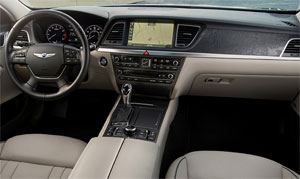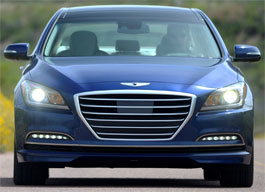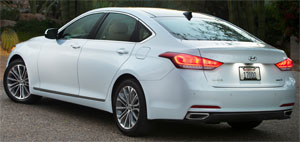2015 Hyundai Genesis
Hyundai’s path from replaceable econobox to highly desirable automotive brand has been a quick one. But, the track of their Genesis sedan from import-premium pretender to notable contender took an even faster pace. And, this 2nd generation of Hyundai’s new beginning appears to be the real deal. So, should established luxury-sports carmakers be worried? Let’s find out.
Hyundai’s Equus may be the brand’s posh flagship. But, it’s the 2015 Genesis that is the most important car for this brand and its efforts to expand into luxury sedan territory, especially if they ever hope to be a notable challenger to Audi, BMW, Mercedes, and other top-tier luxury marques.
That’s because the Genesis is not just a middle weight luxury car, it’s one that Hyundai has infused with enough sportiness to actually make us eager to hop in and drive it. And, when you do, you’ll find some of the seriously good interior quality that is required to be world class. It’s not all there yet, but it’s close. Hyundai has done a fine job of upping the “classy” with genuine materials such as great looking satin finish wood.
 Also to play in this class, it takes the latest in high tech. Updates such as Smart Cruise Control and a Head-Up Display are in line with its competition, while available safety systems like lane keep assist and Sensory Surround have the Genesis bordering on being a self-driving car.
Also to play in this class, it takes the latest in high tech. Updates such as Smart Cruise Control and a Head-Up Display are in line with its competition, while available safety systems like lane keep assist and Sensory Surround have the Genesis bordering on being a self-driving car.
The hands free trunk release is pretty trick. Just stand by the trunk with the key on you for 3-seconds and the lid pops open. Virtual gauges are bold and direct while the general dash layout is very nice.
The driver’s seating position is great, with lots of adjustments and good bolstering, though some found the wide cushions a little on the hard side. The back seat borders on huge, with lots of room to spread out, even for adults.
To be a true luxury contender you also need something else, a “big” grille! The Genesis’s has one even if it is Audi-like. And, in similar fashion, this face will also soon work its way through the rest of the Hyundai brand.
Fractionally longer in overall length, yet with 3-inches more wheelbase, proportions are now more modern. It is without a doubt more upscale, and the longer arching roofline gives Genesis a far more aerodynamic profile. In the rear, panels are more rounded as well; and the jewel-like LED tail lights are mounted high.
 The same 5.0-liter V8 and 3.8-liter V6 engines are available, but both have been revised for smoother operation and better torque delivery. Our tester sported the 311–horsepower V6 and its 293 lb-ft. of torque. The V6 is available with a new HTRAC all-wheel-drive system that works with Intelligent Drive Mode select to divert power forward or rearward depending on wheel slip.
The same 5.0-liter V8 and 3.8-liter V6 engines are available, but both have been revised for smoother operation and better torque delivery. Our tester sported the 311–horsepower V6 and its 293 lb-ft. of torque. The V6 is available with a new HTRAC all-wheel-drive system that works with Intelligent Drive Mode select to divert power forward or rearward depending on wheel slip.
But, all this means less if the makeover de elegance doesn’t carry over to the driving experience. Well, it does, but also to a point. Ride quality is very close to the Big-3 German luxury cars, even if the sporty feel still comes up a tad short.
Things have gotten more responsive and perhaps a little more settled, but when driven aggressively there’s still plenty of roll; nothing a proper ride-and-handling package wouldn’t fix. The V6 engine sounds great, but launching torque is still low, taking our Genesis to 60 in 7.2-seconds.
Response improves markedly as RPMs climb and shifts from the 8-speed automatic transmission are quick yet smooth, making the trip through the quarter mile in 15.4–seconds at 96 miles-per-hour.
Through the cones, steering feel was numb; like most of the Germans; but on the plus side, this rear-driver still retains some of the first gen car’s tossable nature even with its big improvement in smoothness. Braking is not too shabby either, with stops from 60 averaging a short 120–feet.
 The original Genesis sedan surprised us in Biblical proportions. Not just with its luxury feel, but by the fact that we liked driving it a lot. It got Genesis off to a good start and we’ve loved every namesake sedan and coupe we’ve driven since, including this car.
The original Genesis sedan surprised us in Biblical proportions. Not just with its luxury feel, but by the fact that we liked driving it a lot. It got Genesis off to a good start and we’ve loved every namesake sedan and coupe we’ve driven since, including this car.
For which government Fuel Economy Ratings are 18-City, 29-Highway, and 22–Combined. Our 23.4 mile-per-gallon average of Regular was a good one. Though the Energy Impact Score remains average, at 15.0-barrels of oil burned and 6.8 tons of CO2 emitted yearly.
And, as nice as the Genesis has gotten, it’s still a great value proposition. The “more for less-ness” starts at $38,950. Most of its direct competition, with far better name cache, start around $50,000.
Genesis signifies birth. And, while the original 2009 Genesis sedan was certainly that, it’s this 2015 Hyundai Genesis 4-door that has the potential of being a brand changing vehicle, if they can follow up with additional models in the same vein. Then, established luxury makers will have something to worry about. Not so much about losing their current customers, but about attracting future ones.
Specifications
- Engine: 3.8 liter
- Horsepower: 311
- Torque: 293 lb-ft.
- 0-60 mph: 7.2 seconds
- 1/4 mile: 15.4 seconds @ 96 mph
- EPA: 18 mpg city/ 29 mpg highway
- Energy Impact: 15.0 barrels of oil/yr
- CO2 Emissions: 6.8 tons/yr
2025 Infiniti QX80
Infiniti’s Flagship SUV Sets A Course For Extravagance
This full-size Infiniti QX80 started out as the QX56, a hastily rebadged version of Nissan’s truck-based Armada full-size utility. That was in the early 2000s when the luxury SUV craze was exploding. It wasn’t as much as a game-changer, as it was “try to keep upper”. Now, this new QX80, Infiniti is promising to “Reimagine the luxury SUV”. Let’s see if Infiniti has turned their imaginations into reality.
Well, if over the top is what Infiniti was shooting for in the all-new 2025 QX80, mission accomplished. There’s an overall feeling of extravagance here that we haven’t experienced from Infiniti in quite some time.
It’s not just the open pore ash wood trim with aluminum inlays, 24-speaker audio, and plush quilted leather seating; there’s also nicely integrated ambient lighting, a massive glass roof, plenty of tech, lots of active driving assistance, and even chilled center console storage. Forward of that is a dual touchscreen setup; the top 14.3-inch touchscreen for infotainment sits next to the digital gauge display in a single housing; while just below, there’s a 9-inch one for climate controls.
You are reminded this is still a body-on-frame utility the moment you have to climb up into the cockpit, but there’s also the commanding view of the road that comes with that. Captain’s chairs are standard for the second row, but a three-place bench is optional with all trims except for top Autograph which comes exclusively with these climate-controlled massaging chairs, along with a touchscreen control panel. The third-row experience is great, too, with heated leather seating, and adult size room for three.
Now, there is a whole new experience coming from under the hood. The last gen’s V8 has been replaced with a new twin-turbo 3.5-liter V6 rated at 450 horsepower, 50 over the V8. More notably, torque is up by more than 100 lb-ft to 516. Transmission is a nine-speed automatic, two more gears than last year, with rear-wheel drive standard, four-wheel drive an option. Max tow rating is 8,500-lbs.
And at the test track, it did pull strongly off the line, getting up to speed in a hurry with the 0-60 sprint taking just 6.3 seconds. There is roughly 3 tons of weight to push through the quarter-mile, but that twin-turbo does it well, finishing in 14.7 seconds at 95 mph. Gear changes are incredibly smooth, while not hindering acceleration in any way.
It's an impressive looking utility from any angle.
In panic braking runs, there was some fade and a considerable amount of nosedive, but our average stopping distance of 115 feet is not bad for a vehicle as big and heavy as the QX80. Last gen, the QX80 moved from the Titan truck platform to the global Patrol SUV chassis, which shifted the vibe from budget Escalade to Lexus LX fighter. The attending improvement in ride and handling was the real bonus, and that largely continues for this gen with air suspension and Dynamic Digital Dampers on all but base QX80s. While we could certainly feel all that weight through our cone course, body roll was well-controlled and without significant oversteer or understeer.
It’s an impressive looking utility from any angle, starting right up front with the big “bamboo forest” grille. The overall shape is boxy, but all body panels are smooth; and for better or worse, Infiniti joins the flush door handle fad. Look for its “Artistry In Motion” design theme to work its way down through the rest of the Infiniti lineup. All QX80s ride on 22-inch wheels except for base Pure trim which makes do with 20s.
A full power play includes standard motion-activated rear liftgate and power operation of both second and third row seats, expanding cargo capacity from 22 cu-ft behind the third row to 59 behind the second, and a max of 101.0 cu-ft with both rows folded.
Government Fuel Economy Ratings with four-wheel-drive are not great: 16 city, 19 highway and 17 combined. We averaged 18.6 mpg of premium. That’s a much worse than average Energy Impact Score, using 17.5 barrels of oil annually, with 8.6 tons of CO2 emissions.
Driving such a PUREly LUXEurious SENSORY overload, you’ll probably be expecting people to want your AUTOGRAPH, which we’re guessing is how Infiniti came up with their grade structure; pricing starts with Pure at $84,445 and climbs to $112,590 for Autograph.
The 2025 Infiniti QX80 is a massive SUV that delivers massive amounts of power and luxury. They aimed for the moon here and have clearly blasted themselves into a much more competitive orbit in the big buck, big hauler, sport-utility galaxy.
Specifications
As Tested
- Engine: 3.5-liter twin-turbo V6
- Transmission: 9-speed automatic
- Horsepower: 450
- Torque: 516 lb-ft.
- EPA: 16 City | 19 Highway | 17 Combined
- 0-60 mph: 6.3 seconds
- 1/4 Mile: 14.7 seconds at 95 mph
- Braking, 60-0 (avg.): 115 feet
- MW Fuel Economy: 18.6 mpg (Premium)
























































